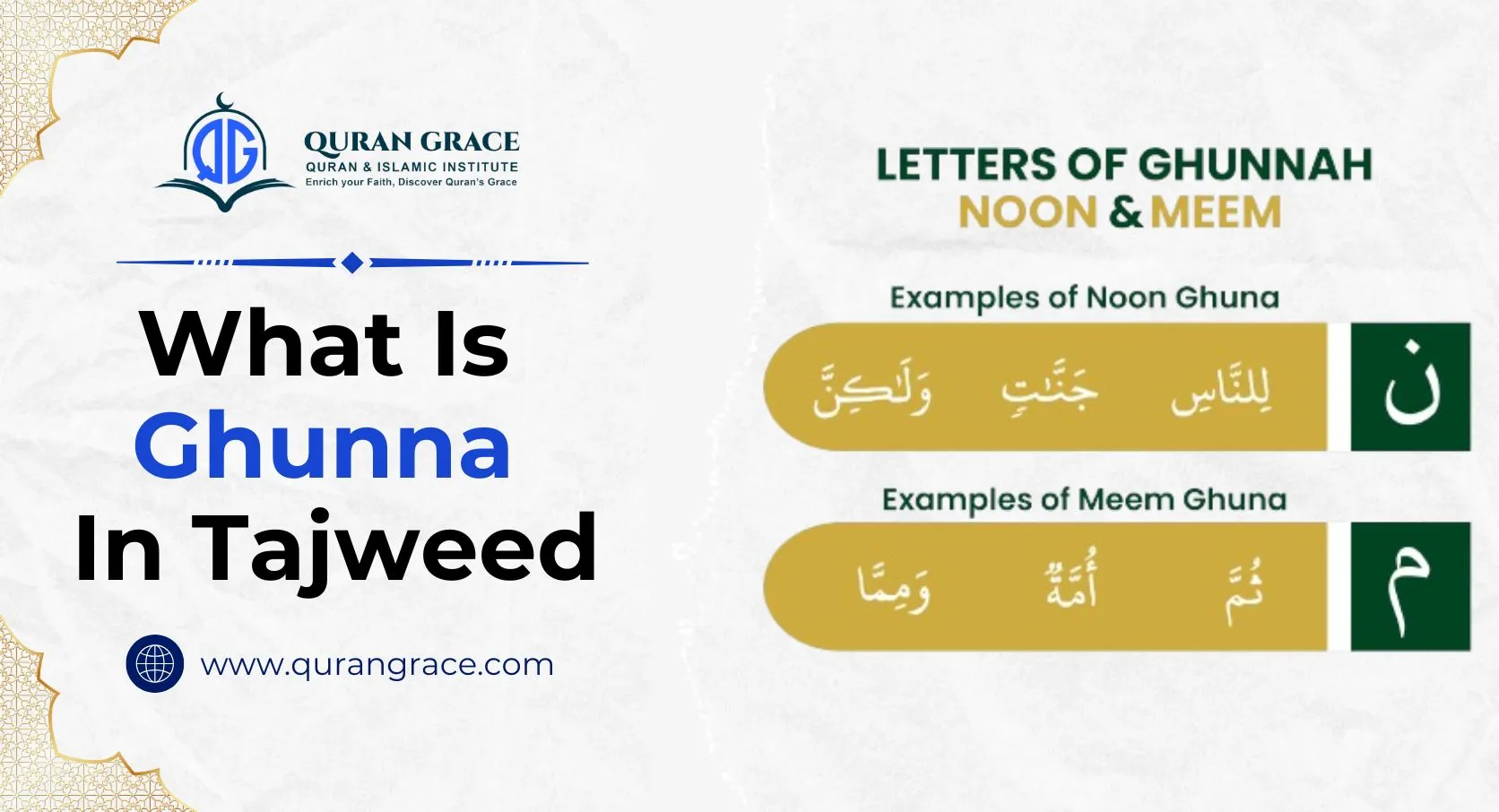Tajweed is crucial for accurate Quran recitation, and one of the major rules of Tajweed is Ghunna, which is a nasal sound that is generated from the nose. Certain letters naturally create vibrations within the nasal cavity. In the realm of Tajweed, this nasalization is considered a mustahab (recommended) practice for proper pronunciation, adding a beautiful touch to Quranic recitation.
Table of Contents
ToggleGhunna in Tajweed
The ghunna sound is produced without using the tongue, lips, or throat; it occurs specifically with particular letters. To properly adhere to Tajweed principles during recitation, it’s crucial to master this technique correctly. Today we will learn all about Ghunna and its rules in detail.
What are Ghunna Letters?
Ghunna is represented by the Arabic letters Meem (م) and Noon (ن) in the study of Tajweed. However, the application of the Ghunna rules extends beyond these two letters. It also applies when these letters are combined with a Shaddah or in conjunction with specific Tajweed rules such as Ikhfa, Idgham, and Iqlab.
Key points regarding Ghunna letters include
- Meem (م) and Noon (ن) are categorized as Ghunna letters because the presence of a Shaddah (ّ) on them creates a distinct nasal sound.
- When these letters carry a Shaddah, the Ghunna sound is typically prolonged for two harakat (or two beats).
- Ghunna can also occur in the absence of a Shaddah when other quran tajweed rules, such as Idgham, Ikhfa, and Iqlab, are applied.
Understanding these elements is crucial for proper pronunciation and recitation in Tajweed.
The Shaddah: (شدة)
When a shaddah (شدة) appears on a letter, it signifies the occurrence of Ghunnah. A shaddah indicates that the associated letter should be emphasized, effectively doubling its sound. For example, in the word “Lil-latheen” (لِلَّذين), the second laam (ل) is pronounced twice. The emphasized sounds in such instances are typically highlighted in red for clarity.
Ghunnah, as per tajweed regulations, is a nasal sound similar to a prolonged “hmm.” It is important to ensure that this sound does not exceed two counts in duration. When encountering a shaddah over the letters noon (ن) or meem (م), it is essential to produce the Ghunnah sound appropriately.
Understanding the concept of Ghunnah is crucial for accurate Quranic recitation. There are four distinct types of Ghunnah, each with specific rules and examples that aid in mastering this aspect of tajweed.
1. The Deepest Ghunnah
This is Meem and Noon Mushaddad, and it is the longest form of Ghunnah. Some verses that illustrate this are “عَمَّ يَتَسَاءَلُون” and “كَلَّا إِنَّهَا تَذْكِرَة.” The duration is two counts.
Idgham with Ghunnah refers to a specific application of nasal sound, where Noon Saakin or Tanween smoothly blend into the following letter, creating a melodious, seamless transition. This phenomenon can be observed in the verse “فَمَن يَعْمَلْ مِثْقَالَ ذَرَّةٍ خَيْرَاً يَرَه,” where the nasalization enhances the overall flow of the recitation.
2. The Complete Ghunnah
This type of ghunnah represents the fullest expression of this nasal sound. It occurs when Noon Saakin or Meem Saakin are succeeded by letters that trigger a process known as Ikhfaa. In these situations, the sound manifests in a subtle yet prominent blend that takes on characteristics of both Izhar and Idgham. For instance, Ikhfaa with Meem Saakin becomes particularly evident before the letter ب, as seen in sentences such as “أَلَمْ يَعْلَم بِأَنَّ اللهَ يَرَى.” This intricate interplay is showcased in verses like “مِن شَرِّ مَا خَلَقَ” and “أَوْ إِطْعَامٌ فِي يَوْمّ ذِي مَسْغَبَة,” where the nasality adds depth to the pronunciation.
3. The Incomplete Ghunnah.
Ths type of ghunnah is characterized by a less pronounced and shorter nasal sound. This type occurs when Meem Saakin or Noon Saakin are articulated clearly or are followed by letters conducive to Izhar. For example, in the verse “فَصَلِّ لِرَبّكَ وَانْحَر,” the presence of Noon Saakin followed by Izhar letters such as ء, هـ, ع, ح, غ, and خ results in a limited expression of Ghunnah, with the nasal sound noticeably subdued. Similarly, in the verse “الذَينَ هُمْ عَن صَلَاتِهِم سَاهُون,” Meem Saakin demonstrates an incomplete Ghunnah when articulated before any letter outside of ب and م, allowing for clarity while still retaining some element of the nasal effect.
This nuanced understanding of Ghunnah not only enriches the recitation but also deepens the listener’s engagement with the text.
Note: To master Ghunnah and its important rules, you can join online Tajweed classes by Quran Grace and excel in Quran recitation like a pro-Qari.
Further Rules of Ghunnah in Tajweed
Several Tajweed regulations emphasize the significance of Ghunna, a vital aspect of proper Quranic recitation. Let’s delve into the main guidelines for effectively applying Ghunna in your reading as students learn these in advanced tajweed course:
-
Idgham with Ghunna
Idgham refers to the concept of assimilating two letters into one. When encountering Tanween or a Noon Saakin, the first letter—specifically, the Noon—merges seamlessly into the second letter. Ghunna, which is a nasal sound, comes into play particularly when the initial letter is followed by the letters Ya (ي), Noon (ن), Meem (م), or Waw (و). For example, in the phrase مَنْ يَعْمَلْ (Man Ya’mal), the Noon Saakin merges with the Ya, and the reciter applies Ghunna for two full counts, creating a distinct nasal echo that enriches the recitation.
-
Ikhfa with Ghunna
Ikhfa introduces a unique technique in which the sound of Noon Saakin or Tanween is “hidden” or partially articulated. This blending occurs when the Noon is placed before specific letters. With a total of twenty-two letters associated with Ikhfa, including Ta (ت), Dal (د), Kaf (ك), and others, this method requires a softening of the sound accompanied by a nasal Ghunna for two counts. An illustrative example is found in يُنذِرُونَ (Yunziruna), where the Noon Saakin is subtly concealed before the Dhal (ذ), necessitating a gentle nasal resonance that enhances the overall fluency of the verse.
-
Iqlab with Ghunna
Iqlab presents a fascinating shift where the letter Ba (ب) precedes a Meem (م), effectively substituting for the Noon Saakin or Tanween. This alteration calls for the incorporation of Ghunna as the reciter articulates a nasal sound for two counts, augmenting the melodic quality of the recitation. For instance, in the phrase مَنْ بَعَثَ (Man Ba’atha), the Noon Saakin transitions into a Meem, necessitating a nasal Ghunna that adds depth to the recitation.
-
Meem with Shaddah
The presence of a Shaddah on the letter Meem (م) requires the application of a complete Ghunna for two counts. This rule mirrors the treatment of Noon with Shaddah, underscoring the importance of maintaining consistent nasal quality. Take, for example, the word ثُمَّ (Thumma); here, the Meem is accompanied by a Shaddah, and the reciter must employ a full nasal Ghunna, enriching the melodic flow and demonstrating the beauty of proper Tajweed.
Each of these guidelines emphasizes the importance of Ghunna, enhancing not just the accuracy of recitation but also the beauty and expressiveness of the Quranic text.
Examples of Ghunna in the Quran
When you witness ghunna in a genuine Quranic recitation, it becomes easier to comprehend. Several examples of Ghunna’s use in the Quran are as follows:
- The Noon with Shaddah demands a complete Ghunna on two counts.إِنَّهُ عَلَىٰ كُلِّ شَيْءٍ قَدِيرٌ
- The Noon Saakin unites with the Ya, exhibiting Idgham with Ghunna. مَنْ يَعْمَلْ سُوءًا.
- Here, the Noon with Tanween hides before the Fa, using Ikhfa in conjunction with Ghunna. كُلٌّ فِي فَلَكٍ
- Using Ghunna and Iqlab, the Noon Saakin transforms into Meem. مَنْ بَعَثَ
These examples illustrate how Ghunna is applied in Quranic recitation, enhancing the beauty and accuracy of the pronunciation.
Recognizing Ghunna in the Quran
Understanding the letters and rules associated with Ghunna can help you easily identify them while reading the Quran. Here are a few tips to recognize Ghunna effectively:
- Look for the presence of Shaddah (ّ) on the letters Noon (ن) and Meem (م). These letters indicate that Ghunna should be applied.
- When you encounter Tanween or Noon Saakin, check if the following letter aligns with the regulations of Ghunna—such as Idgham, Ikhfa, or Iqlab.
- To ensure you’re performing Ghunna correctly, a simple trick is to place your finger on the center of your nose. If you feel a vibration there, it indicates that you’re executing Ghunna perfectly.
- In Tajweed, Ghunna is often highlighted using different colours to show exactly where and when it should be applied.
By keeping these points in mind, you can enhance your reading and understanding of Ghunna in the Quran.
Conclusion
To effectively learn the Quran with all Tajweed rules, regular practice of rules is important. For an in-depth understanding of these rules, Quran Grace offers tajweed course for all ages with a structured approach. So, join tajweed classes for adults, tajweed for children, and online tajweed classes for sisters to discover and develop your skills and enhance your quran learning today.








